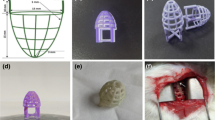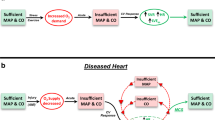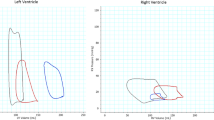Abstract
We have used a novel active hydraulic ventricular support drug delivery system (ASD) device, which is a non-transplant surgical approach, can adhere to heart surface, and deliver the drug directly into the epicardium. This study is intended to compare the effect of administration of nitroglycerine (NTG) through ASD and intravenous injection on the ischemic injury during acute myocardial infarction (AMI). 30 male SD rats were allocated into five groups (n = 6): sham, AMI, I.V., ASD high dose (ASDH), and ASD low dose (ASDL) respectively. Ligation of the left anterior descending (LAD) coronary artery was performed to induce myocardial infarction. Electrocardiograms were monitored, and serum myoglobin (Mb) was assessed. Hemodynamics was observed on pre- and post-operation. Hematoxylin and eosin (H&E) staining was performed for histological diagnosis. In all model animals, ligation of LAD provoked ST segment elevation and Mb level augmentation. In ASDH group, Mb showed obvious decrease as compared with other treatment groups. Hemodynamic parameters showed significant improvement in ASDH and ASDL groups than the I.V. group. H&E staining showed that AMI group rats had wavy fibers and loss of transverse striations while ASD group rats had obvious improvement. Unlike the I.V. group, ASD group rats showed significant vasodilation. Therefore, delivery of NTG through ASD to the cardiomyocytes could improve the therapeutic efficacy. A novel effective route for local delivery of agents to manage AMI has been proved.









Similar content being viewed by others
References
White HD, Chew DP. Acute myocardial infarction. Lancet. 2008;372:570–84. https://doi.org/10.1016/S0140-6736(08)61237-4.
Sun Y. Myocardial repair/remodelling following infarction: roles of local factors. Cardiovasc Res. 2008;81:482–90. https://doi.org/10.1093/cvr/cvn333.
Zhang Y, Li C, Meng H, Guo D, Zhang Q, Lu W, et al. BYD ameliorates oxidative stress-induced myocardial apoptosis in heart failure post-acute myocardial infarction via the P38 MAPK-CRYAB signaling pathway. Front Physiol. 2018;9:505. https://doi.org/10.3389/fphys.2018.00505.
Aisa Z, Liao G-C, Shen X-L, Chen J, Li L, Jiang S-B. Effect of autophagy on myocardial infarction and its mechanism. Eur Rev Med Pharmacol Sci. 2017;21:3705–13.
Rezkalla SH, Kloner RA. No-reflow phenomenon. Circulation. 2002;105:656–62. https://doi.org/10.1161/hc0502.102867.
Do HP, Ramanan V, Qi X, Barry J, Wright GA, Ghugre NR, et al. Non-contrast assessment of microvascular integrity using arterial spin labeled cardiovascular magnetic resonance in a porcine model of acute myocardial infarction. J Cardiovasc Magn Reson. 2018;20:45. https://doi.org/10.1186/s12968-018-0468-5.
Yang X, Qin Y, Shao S, Yu Y, Zhang C, Dong H, et al. MicroRNA-214 inhibits left ventricular remodeling in an acute myocardial infarction rat model by suppressing cellular apoptosis via the phosphatase and tensin homolog (PTEN). Int Heart J. 2016;57:247–50. https://doi.org/10.1536/ihj.15-293.
Berk BC, Fujiwara K, Lehoux S. ECM remodeling in hypertensive heart disease. J Clin Invest. 2007;117:568–75. https://doi.org/10.1172/JCI31044.
Achary D, Loyaga-Rendon RY, Pamboukian SV, Tallaj JA, Holman WL, Cantor RS, et al. Ventricular assist device in acute myocardial infarction. J Am Coll Cardiol. 2016;67:1871–80. https://doi.org/10.1016/j.jacc.2016.02.025.
Sidhu M, Boden WE, Padala SK, Cabral K, Buschmann I. Role of short-acting nitroglycerin in the management of ischemic heart disease. Drug Des Devel Ther. 2015;9:4793. https://doi.org/10.2147/DDDT.S79116.
Abrams J. Nitroglycerin and long-acting nitrates in clinical practice. Am J Med. 1983;74:85–94.
Kones R. Recent advances in the management of chronic stable angina II. Anti-ischemic therapy, options for refractory angina, risk factor reduction, and revascularization. Vasc Health Risk Manag. 2010;6:749–74.
Shah RV, Holmes D, Anderson M, Wang TY, Kontos MC, Wiviott SD, et al. Risk of heart failure complication during hospitalization for acute myocardial infarction in a contemporary population. Circ Hear Fail. 2012;5:693–702. https://doi.org/10.1161/CIRCHEARTFAILURE.112.968180.
Schlaifer M, Rouse MJ. Scope of contemporary pharmacy practice: roles, responsibilities, and functions of pharmacists and pharmacy technicians. J Manag Care Pharm. 2010;16:507–8.
Schiffrin EL. Oxidative stress, nitric oxide synthase, and superoxide dismutase. Hypertension. 2008;51:31–2. https://doi.org/10.1161/HYPERTENSIONAHA.107.103226.
Downey James M, Fred DH, Kirk Edward S. Effects of myocardial strains on coronary blood flow. Circ Res. 1974;34:286–92. https://doi.org/10.1161/01.RES.34.3.286.
Sutton RL. The absorption of ointments. BMJ. 1908;1:1225–5. https://doi.org/10.1136/bmj.1.2473.1225.
Kumar K, Nguyen K, Waxman S, Nearing BD, Wellenius GA, Zhao SX, et al. Potent antifibrillatory effects of intrapericardial nitroglycerin in the ischemic porcine heart. J Am Coll Cardiol. 2003;41:1831–7. https://doi.org/10.1016/S0735-1097(03)00340-1.
Verrier RL, Waxman S, Lovett EG, Moreno R. Transatrial access to the normal pericardial space: a novel approach for diagnostic sampling, pericardiocentesis, and therapeutic interventions. Circulation. 1998;98:2331–3.
Wenk JF, Ge L, Zhang Z, Mojsejenko D, Potter DD, Tseng EE, et al. Biventricular finite element modeling of the Acorn CorCap Cardiac Support Device on a failing heart. Ann Thorac Surg. 2013;95:2022–7.
Kubota Y, Miyagawa S, Fukushima S, Saito A, Watabe H, Daimon T, et al. Impact of cardiac support device combined with slow-release prostacyclin agonist in a canine ischemic cardiomyopathy model. J Thorac Cardiovasc Surg. 2014;147:1081–7.
Oliveira GH, Qattan MY, Al-Kindi S, Park SJ. Advanced heart failure therapies for patients with chemotherapy-induced cardiomyopathy. Circ Hear Fail. 2014;7:1050–8.
Magovern JA. Experimental and clinical studies with the Paracor cardiac restraint device. Semin. Thorac. Cardiovasc. Surg., vol. 17, Elsevier; 2005, с 364–8.
Ghanta RK, Rangaraj A, Umakanthan R, Lee L, Laurence RG, Fox JA, et al. Adjustable, physiological ventricular restraint improves left ventricular mechanics and reduces dilatation in an ovine model of chronic heart failure. Circulation. 2007;115:1201–10.
Naveed M, Mohammad IS, Xue L, Khan S, Gang W, Cao Y, et al. The promising future of ventricular restraint therapy for the management of end-stage heart failure. Biomed Pharmacother. 2018;99:25–32. https://doi.org/10.1016/j.biopha.2018.01.003.
Naveed M, Wenhua L, Gang W, Mohammad IS, Abbas M, Liao X, et al. A novel ventricular restraint device (ASD) repetitively deliver Salvia miltiorrhiza to epicardium have good curative effects in heart failure management. Biomed Pharmacother. 2017;95:701–10. https://doi.org/10.1016/j.biopha.2017.07.126.
Yasmeen S, Liao X, Khan FU, Ihsan AU, Li X, Li C, et al. A novel approach to devise the therapy for ventricular fibrillation by epicardial delivery of lidocaine using active hydraulic ventricular attaching support system: an experimental study in rats. J Biomed Mater Res Part B Appl Biomater. 2018;107:1722–31. https://doi.org/10.1002/jbm.b.34265.
Yue S, Naveed M, Gang W, Chen D, Wang Z, Yu F, et al. Cardiac support device (ASD) delivers bone marrow stem cells repetitively to epicardium has promising curative effects in advanced heart failure. Biomed Microdevices. 2018;20:40. https://doi.org/10.1007/s10544-018-0282-8.
Zhou Xiaohui. Active hydraulic ventricular attaching support system, 2010.
Lee TH, Goldman L. Serum enzyme assays in the diagnosis of acute myocardial infarction. Recommendations based on a quantitative analysis. Ann Intern Med. 1986;105:221–33.
Takimoto Y, Aoyama T, Tanaka K, Keyamura R, Yui Y, Sasayama S. Augmented expression of neuronal nitric oxide synthase in the atria parasympathetically decreases heart rate during acute myocardial infarction in rats. Circulation. 2002;105:490–6. https://doi.org/10.1161/hc0402.102662.
Qin Y, Yu Y, Dong H, Bian X, Guo X, Dong S. MicroRNA 21 inhibits left ventricular remodeling in the early phase of rat model with ischemia-reperfusion injury by suppressing cell apoptosis. Int J Med Sci. 2012;9:413–23. https://doi.org/10.7150/ijms.4514.
Mehdizadeh R, Parizadeh M-R, Khooei A-R, Mehri S, Hosseinzadeh H. Cardioprotective effect of saffron extract and safranal in isoproterenol-induced myocardial infarction in Wistar rats. Iran J Basic Med Sci. 2013;16:56–63.
Folkman J, Long DM. The use of silicone rubber as a carrier for prolonged drug therapy. J Surg Res. 1964;4:139–42.
Hudson SP, Padera RF, Langer R, Kohane DS. The biocompatibility of mesoporous silicates. Biomaterials. 2008;29:4045–55. https://doi.org/10.1016/j.biomaterials.2008.07.007.
Roche ET, Horvath MA, Wamala I, Alazmani A, Song S-E, Whyte W, et al. Soft robotic sleeve supports heart function. Sci Transl Med. 2017;9:eaaf3925. https://doi.org/10.1126/scitranslmed.aaf3925.
Ghanta RK, Lee LS, Umakanthan R, Laurence RG, Fox JA, Bolman RM III, et al. Real-time adjustment of ventricular restraint therapy in heart failure☆. Eur J Cardio-Thoracic Surg. 2008;34:1136–40. https://doi.org/10.1016/j.ejcts.2008.07.013.
Naveed M, Wenhua L, Gang W, Mohammad IS, Abbas M, Liao X, et al. A novel ventricular restraint device (ASD) repetitively deliver Salvia miltiorrhiza to epicardium have good curative effects in heart failure management. Biomed Pharmacother. 2017;95:701–10. https://doi.org/10.1016/j.biopha.2017.07.126.
Naveed M, Han L, Jilany G, Mikrani R. Biomedicine & Pharmacotherapy Cardio-supportive devices (VRD & DCC device) and patches for advanced heart failure : a review , summary of state of the art and future directions 2018;102:41–54. https://doi.org/10.1016/j.biopha.2018.03.049.
Mancini D, Colombo PC. Left ventricular assist devices. J Am Coll Cardiol. 2015;65:2542–55. https://doi.org/10.1016/j.jacc.2015.04.039.
Bøttcher M, Madsen MM, Randsbaek F, Refsgaard J, Dørup I, Sørensen K, et al. Effect of oral nitroglycerin and cold stress on myocardial perfusion in areas subtended by stenosed and nonstenosed coronary arteries. Am J Cardiol. 2002;89:1019–24. https://doi.org/10.1016/S0002-9149(02)02268-3.
Waxman S, Moreno R, Rowe KA, Verrier RL. Persistent primary coronary dilation induced by transatrial delivery of nitroglycerin into the pericardial space: a novel approach for local cardiac drug delivery. J Am Coll Cardiol. 1999;33:2073–7.
Divakaran S, Loscalzo J. The role of nitroglycerin and other nitrogen oxides in cardiovascular therapeutics. J Am Coll Cardiol. 2017;70:2393–410. https://doi.org/10.1016/j.jacc.2017.09.1064.
Dave RH, Hale SL, Kloner RA. Hypothermic, closed circuit pericardioperfusion: a potential cardioprotective technique in acute regional ischemia. J Am Coll Cardiol. 1998;31:1667–71.
Weber M, Rau M, Madlener K, Elsaesser A, Bankovic D, Mitrovic V, et al. Diagnostic utility of new immunoassays for the cardiac markers cTnI, myoglobin and CK-MB mass. Clin Biochem. 2005;38:1027–30. https://doi.org/10.1016/j.clinbiochem.2005.07.011.
Ren J, Li C, Ma S, Wu J, Yang Y. Impact of dexmedetomidine on hemodynamics in rabbits. Acta Cir Bras. 2018;33:314–23. https://doi.org/10.1590/s0102-865020180040000003.
Settergren G. The calculation of left ventricular stroke work index. Acta Anaesthesiol Scand. 1986;30:450–2.
Hamlin RL, del Rio C. dP/dt(max)--a measure of “baroinometry”. J Pharmacol Toxicol Methods. 2012;66:63–5. https://doi.org/10.1016/j.vascn.2012.01.001.
Cubeddu RJ, Don CW, Horvath SA, Gupta PP, Cruz-Gonzalez I, Witzke C, et al. Left ventricular end-diastolic pressure as an independent predictor of outcome during balloon aortic valvuloplasty. Catheter Cardiovasc Interv. 2014;83:782–8. https://doi.org/10.1002/ccd.24410.
Mielniczuk LM, Lamas GA, Flaker GC, Mitchell G, Smith SC, Gersh BJ, et al. Left ventricular end-diastolic pressure and risk of subsequent heart failure in patients following an acute myocardial infarction. Congest Heart Fail. 2007;13:209–14.
Willerson JT, Igo SR, Yao SK, Ober JC, Macris MP, Ferguson JJ. Localized administration of sodium nitroprusside enhances its protection against platelet aggregation in stenosed and injured coronary arteries. Texas Hear Inst J. 1996;23:1–8.
Narita T, Shintani Y, Ikebe C, Kaneko M, Campbell NG, Coppen SR, et al. The use of scaffold-free cell sheet technique to refine mesenchymal stromal cell-based therapy for heart failure. Mol Ther. 2013;21:860–7. https://doi.org/10.1038/mt.2013.9.
Funding
This work was supported by the National Found for Fostering Talents of Basic Science (NFFTBS), [grant number J1030830], the National Natural Science Foundation of China [grant numbers 30973003; 30901993], and the Administration of TCM of Jiangsu Province [grant number LZ11093].
Author information
Authors and Affiliations
Corresponding author
Ethics declarations
Conflict of interest
The authors declare that they have no conflict of interest.
Additional information
Publisher’s note
Springer Nature remains neutral with regard to jurisdictional claims in published maps and institutional affiliations.
Xue Li and Reyaj Mikrani are co-first authors
Lei Han, Zhijie Wang and Xiaohui Zhou are co-corresponding authors
Rights and permissions
About this article
Cite this article
Li, X., Mikrani, R., Li, C. et al. An epicardial delivery of nitroglycerine by active hydraulic ventricular support drug delivery system improves cardiac function in a rat model. Drug Deliv. and Transl. Res. 10, 23–33 (2020). https://doi.org/10.1007/s13346-019-00656-9
Published:
Issue Date:
DOI: https://doi.org/10.1007/s13346-019-00656-9




